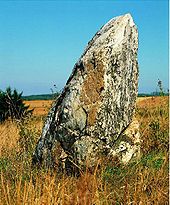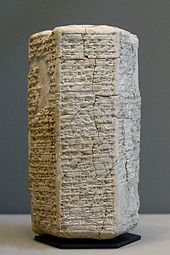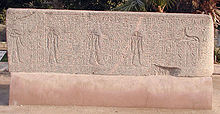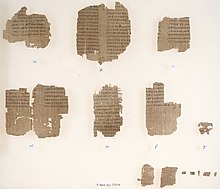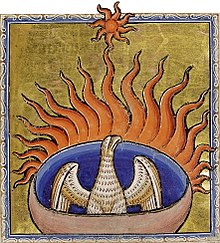History of the written media
When writing materials, writing means or written media to all designated from the oldest to the most recent time all materials and articles that conventionally as carriers of font used - as opposed to writing materials (all serving for writing materials, tools and equipment, such as writing instrument ). Depending on whether it is written or printed material, one speaks of writing material and printing material .
historical overview
Mounds of earth, tree plantings, piles of stones, rock walls, stakes and crosses were the first characters in the broadest sense, the others documented that the dead rested there, great deeds had happened or which way leads from here to the next settlement. In the case of these memorials and memorials - analogous to written script in the narrower sense - the oral tradition (tradition) provided the further explanation; Gradually indicative figures were added to distinguish and aid memory.
Already in the oldest times the writing was pressed with chopsticks as figures and wedges in clay plates , which were then dried in the sun, as finds in old Akkad ( Chaldea ) show. The same was done in Nineveh , Babylon and Sipphara ( City of Books ), in the cities between the Tigris and the Euphrates . In the event of flooding , most of the clay libraries were lost along with the clay houses . That is why the clay masses were later burned, just as the bricks formed for buildings were burned into bricks ( sigillae ).
In countries without clay deposits, attempts were first made to use the most suitable types of stone for engraving writing, which at the same time would be expected to be very durable. Slate , marble , plaster of paris , porphyry (the ancient purple ) and limestone were the writing materials used in the stone libraries of the Chinese , Aryans , Iranians and Egyptians . Chisels , wedges and mallets had taken the place of the chopsticks .
In the 4th millennium BC The script was probably used first for business texts, cult and astronomy , later in the course of the formation of states such as Sumer , Egypt , China , Chaldea , Assyria , Babylon for the documentation of laws, the glory of the rulers during their lifetime and especially during Death by the construction of tombs with information about the dead ( Lypogea , pyramids ). Stone inscriptions are still used today on cemeteries , monuments and memorial plaques .
The colossal hieroglyph was reduced in size among all peoples to the hieratic and finally to the demotic (popular) script. Trade and science demanded more and more frequent and thus more compact records. The stone material had to be abandoned and materials from the plant and animal kingdoms began to be used.
Wooden panels
In China , in particular , the use of wooden tablets can be traced back to antiquity. The wooden panels (tabellae) were coated with colored wax , which was scratched down to the white background with a stylus (stilus), which was usually made of iron , lead or ivory . At the other end it had a flat, spatulate shape that was used to spread the wax. Hence the expression stilum vertere to turn the stylus, to correct. Many panels could be tied together with cords through eyelets and resulted in the codex . The two outer panels were protection and binding , which is why they could only be written on on the inside.
leather
Untanned hides , leather , in the form of broad strips and straps, found their way into the Persians , Medes , Assyrians and Hebrews . The untanned hides were written on with Indian ink made from soot and oil , the tanned hides with a thickened solution of copper water ( chalcantum ), both species corresponding to a writing tube ( calamus , from Greek kalamos ), which was later explained about the alum skins and 183 BC. Led the king Eumenes II of Pergamos to the preparation of the parchment named after it .
Palm leaves and others
From East Asia to India , on most of the South Sea islands and on the East African coast, the palm leaves of Corypha umbraculifera and some other fleshy leaf species ( aloe ) were used, while in the Middle East to Greece , animal bones cut into leaves (plates) , ivory , mussel shells and used the like and with these, as with those, scratched the writing with a pointed stylus and blackened it with oil soot.
In North America, some tribes used the bark of the paper birch for descriptive purposes .
papyrus
Papyrus was mainly produced in ancient Egypt and has been preserved to this day thanks to the dry and therefore well-conserving sand. Due to the production , it was only on one side writable. A papyrus roll was usually about six to ten meters long and 25-30 cm wide. Extremely long rolls like Homer's main work reach a length of 81 meters. For reasons of handling, the majority bought loose sheets of paper that they could write on and then put together with a clever glue (glutinator).
A typical papyrus roll is like our newspaper today: two columns with the same number of lines and 35 letters (corresponds to a hexameter ). The width to the edge varied. A larger border was considered more elegant and added value to the entire role. In addition, the author could add comments (scholias). Due to the fragility of the material, a rod (umbilicus) made of wood or ivory was mounted below. A label with a title on the upper edge provided information about the content and author.
The extensive trade of the Egyptians since ancient times and the lack of other suitable material had stimulated this highly cultured people to look for such fine written material as the papyrus sheet glued across one another. The papyrus industry was highly developed, and Alexandria and the entire delta region had numerous important workshops. The income from the papyrus industry was enough to support the Egyptian army. Until around 100 BC Chr. One wrote only on papyrus until the parchment appeared, which prevailed towards the end of the 7th century.
parchment
Parchment is a writing material made from animal skin , with sheep skin being preferred. It was depilated, cleaned, stretched, dried and then smoothed. Unlike papyrus, parchment could be written on on both sides. It was immersed in an acid and base bath for cleaning. After writing on, parchment could be scraped off again if necessary and then rewritten.
Parchment found its way into Europe at the end of the 6th century and was used there until the end of the 13th century, when cotton paper from Syria later appeared in Sicily and Spain (see paper ). Birch bark was also used in northern Europe .
As for papyrus, a sharpened writing tube (calamus), mostly made of reed, was used as a writing instrument for parchment . As with the later steel springs , the tip was split so that the capillary effect could occur. Since the beginning of the 7th century, raven and goose feathers ( quill pen ) have been used in European offices . The wealthy used ivory feathers .
One wrote with Indian ink, which was also used for cotton paper in Asia and Egypt. The ink was probably brought to Europe by rabbis from the Orient around the 4th century . It was black due to the mixture of water , glue and soot (aqua tincta or atramentum). Their excellent quality has been proven by their durability .
paper
The invention of linen paper made from worn fabrics has replaced all other writing and writing materials in the whole world (except for China, Japan and Korea); In place of the quill , the silver nib could be used since 1830 and soon afterwards the steel nib (see pen nib # metal feathers )
While the creation of texts by hand was slow and required little writing material, the invention of the printing press ushered in a new era. The demand for paper increased dramatically.
The knowledge to be written down developed in such a way that books were initially reduced to microfiche in the 20th century and texts were finally stored digitally.
Data carriers for computer-based reading systems
Computers can digitally manage texts on storage media and control the transfer to data carriers . Computer-based data carriers are therefore also classed as written media. With a data carrier, the type of material is less important, it just depends on whether it can be written with a binary code and read out again.
The writing is not printed directly on the material and cannot be read with the naked eye. The medium (often optically or mechanically influenced or magnetizable material) is therefore only an indirect carrier of the data bits . The stored binary code itself only contains numbers that have to be interpreted by the computer. In order for the interpretation to result in a written image, an electronic reading device suitable for the data carrier and an interpreting program suitable for the code used must be available. The still frequently used ASCII coding for the individual letters is increasingly being replaced by Unicode . The layout or the letter arrangement and style formatting for display on a screen or for printing is controlled by hypertext markup program languages such as HTML .
However, the pace of development in data formats creates new problems in long-term archiving .
Once the writing has been decoded, it can be made visible again using an imaging process. In the early days of computing, printers did this job. Nowadays it is mostly screens that display a font. The trend towards mobile laptops and PDAs as well as research on electronic paper show that the development of written media is not standing still.
